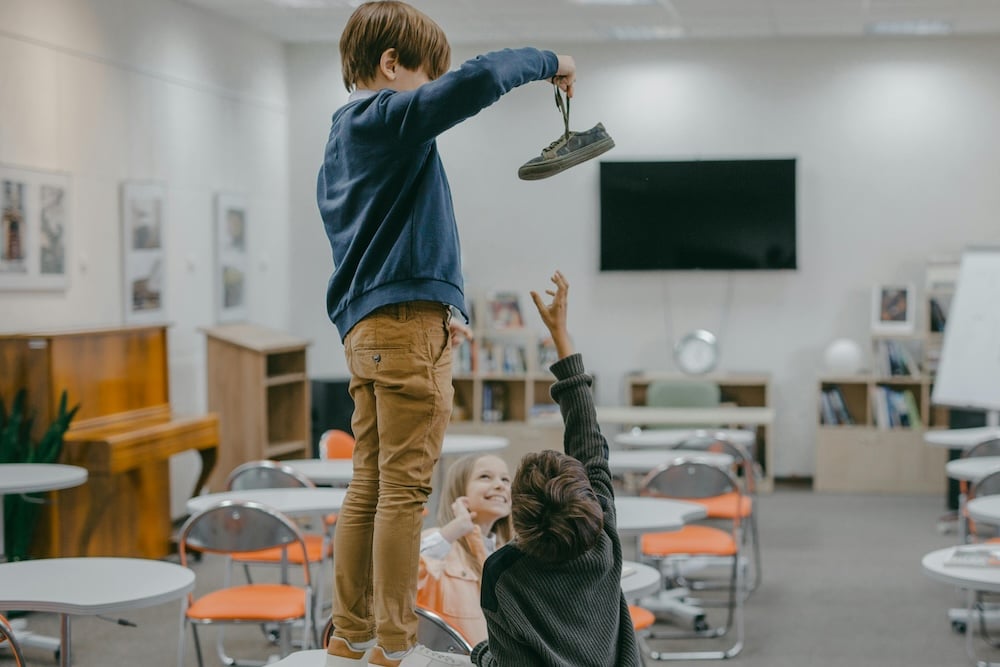When students act out or withdraw, it can be easy to label their actions as misbehavior. But behind every challenging behavior is a deeper story—a need that isn’t being met or an emotion that’s difficult to express. As educators and caregivers, the opportunity is not in reacting with punishment, but in responding with curiosity, connection, and tools that nurture emotional growth.
This is the heart of social emotional learning, and the shift it encourages in how we view challenging behaviors in the classroom. This shift can change lives, both for students and for the educators who guide them.
What are challenging behaviors?
Challenging behaviors can take many forms: defiance, outbursts, shutting down, refusal to participate, aggression, or even excessive silliness. While some challenging behavior examples may appear disruptive, others are more subtle but still indicate a need for support.
The key is recognizing that these behaviors are communication.
Whether a child is feeling overwhelmed, unheard, unsafe, or simply dysregulated, their behavior is often the visible signal of something deeper happening within.
From control to connection: Reframing the response
Traditional discipline methods often focus on control—timeouts, detentions, or rewards and consequences. These strategies may suppress behavior in the short term, but they don’t address the root cause.
Shifting to a connection-based approach means we start by asking: Why is this behavior showing up right now?
Curiosity opens the door to understanding, while connection provides the safety kids need to learn new skills. This doesn’t mean excusing the behavior, but rather guiding students through it with compassion, boundaries, and tools for self-regulation.
How to deal with challenging behaviors in the classroom

Here are practical ways to shift your approach to managing challenging behaviors:
1. Lead with empathy
Before responding, pause. Ask yourself what the child might be feeling or needing. A regulated adult helps regulate the child.
2. Name the emotion
Help students identify what they’re feeling. “You seem frustrated. Do you want to talk or take a break?” Naming emotions helps kids develop emotional literacy.
3. Offer choice
When students feel powerless, giving small, meaningful choices can restore a sense of control in healthy ways.
4. Use connection tools
Use community agreements, check-ins, and mindfulness tools like Tools of the Heart to reconnect students with their values and calm their nervous systems.
5. Create safe spaces for regulation
A cozy corner, a peace table, or a sensory box can give students a place to cool down and return to the group when ready.
Understanding the roots: Why behaviors show up
Understanding how to handle challenging behavior in the classroom means tuning into the reasons these behaviors arise. Some common causes include:
- Unmet needs (hunger, sleep, overstimulation)
- Stress or trauma
- Learning differences
- Social struggles or a lack of skills
- Feeling disconnected or misunderstood
By seeing challenging behaviors as signals rather than defiance, educators can respond with intention and help students build the skills they need to succeed.
Teaching through behavior: Opportunities for growth
Moments of dysregulation are also moments of opportunity. They’re a chance to teach:
- Self-awareness (What am I feeling?)
- Self-regulation (What can I do with this feeling?)
- Empathy (How does my behavior affect others?)
- Repair (What can I do to make things right?)
All of these are central components of social emotional learning and help lay the foundation for a safe and respectful classroom community.
Integrating SEL into your classroom culture
Proactive classroom management doesn’t mean stricter rules—it means deeper relationships and embedded SEL practices that meet kids where they are.
Some ways to make this part of your classroom:
- Morning check-ins to build emotional awareness
- Class meetings to talk about feelings, issues, and resolutions
- Role-playing to practice challenging behavior examples and better choices
- The Empty Balloon Exercise from our Tools of the Heart curriculum helps students learn emotional release
When students understand themselves and feel safe expressing big feelings, challenging behaviors in the classroom become less frequent and more manageable.
Support for educators and school communities
Responding to challenging behaviors with compassion and structure takes time and intention. But you don’t have to do it alone.
Soul Shoppe’s Elementary SEL curriculum includes tools and lessons that help educators integrate empathy-based strategies in their classrooms. These practices empower students to take responsibility, make repairs, and grow.
Learn more about how to build stronger relationships and safer spaces with social emotional learning.
Final Thoughts: The power of shifting focus
When a child’s behavior challenges us, it’s easy to feel stuck or frustrated. But by shifting from punishment to connection, from blame to curiosity, we meet children where they are—and help them rise.
Understanding how to deal with challenging behaviors in the classroom isn’t just about managing a moment. It’s about shaping a future where all students feel seen, safe, and capable of change.
You May Also Like:


